Do you need lvm in linux?
May 14, 2023 pm 08:49 PM
Linux uses lvm. LVM refers to logical volume management, which is a mechanism for managing disk partitions in the Linux environment. LVM is a logical layer built on the hard disk and partitions to improve the flexibility of disk partition management. The biggest feature of LVM is that it can dynamically manage disks. Because the size of the logical volume can be dynamically adjusted without losing existing data; if a new hard disk is added, it will not change the existing upper logical volume. As a dynamic disk management mechanism, logical volume technology greatly improves the flexibility of disk management.
Introduction to LVM
LVM is the abbreviation of Logical Volume Manager. It is a mechanism for managing disk partitions in the Linux environment. LVM is built on A logical layer above hard disks and partitions to improve the flexibility of disk partition management.
The working principle of LVM is actually very simple. It abstracts and encapsulates the underlying physical hard disk and then presents it to upper-layer applications in the form of logical volumes. In the traditional disk management mechanism, our upper-layer application directly accesses the file system to read the underlying physical hard disk. In LVM, it encapsulates the underlying physical hard disk. When we read the underlying physical hard disk, When operating, it no longer operates on partitions, but performs underlying disk management operations through something called a logical volume. For example, if I add a physical hard disk, the upper-layer service will not be aware of it at this time, because it is presented to the upper-layer service in the form of a logical volume.
The biggest feature of LVM is that it can dynamically manage disks. Because the size of the logical volume can be dynamically adjusted without losing existing data. If we add a new hard disk, it will not change the existing upper logical volume. As a dynamic disk management mechanism, logical volume technology greatly improves the flexibility of disk management.
Basic logical volume management concepts:
PV (Physical Volume) - Physical Volume
The physical volume is in the logical volume management At the lowest level, it can be the partition on the actual physical hard disk, the entire physical hard disk, or the raid device.VG (Volumne Group) - Volume Group
A volume group is built on a physical volume. A volume group must include at least one physical volume. After the volume group is created, it can be dynamic Add physical volumes to the volume group. A logical volume management system project can have only one volume group or multiple volume groups.LV (Logical Volume) - Logical Volume
Logical volumes are built on volume groups. The unallocated space in the volume groups can be used to create new logical volumes. Logical volumes Once established, the space can be expanded and reduced dynamically. Multiple logical volumes in the system can belong to the same volume group or to multiple different volume groups.
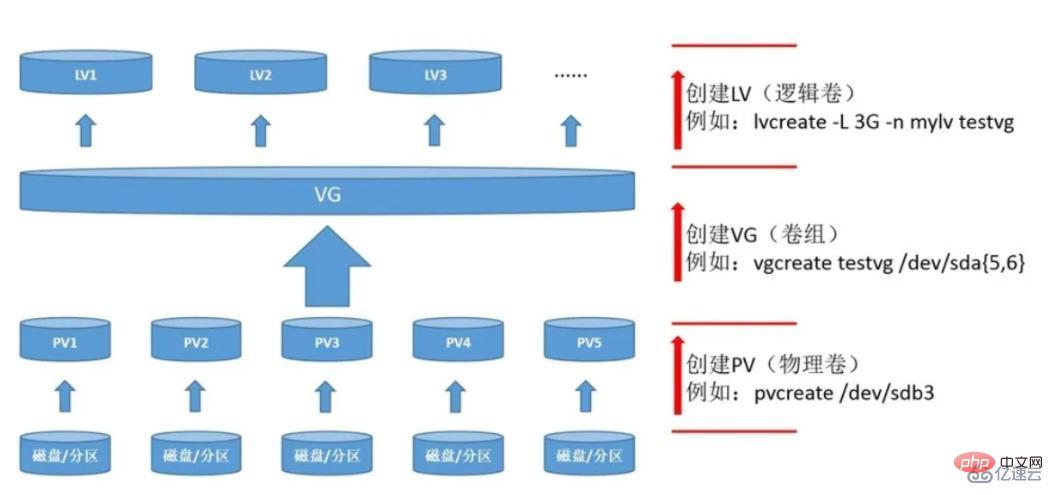
-
PE (Physical Extent) - Physical block
LVM uses 4MB PE block by default. The LVM LV can only contain up to 65534 PEs (lvm1 format), so the default LVM LV maximum capacity is 4M*65534/(1024M/G)=256G. PE is the smallest storage block of the entire LVM. In other words, our data is actually processed by writing to PE. Simply put, this PE is a bit like the block size in the file system. Therefore, adjusting PE will affect the maximum capacity of LVM! However, after CentOS 6.x, this limitation no longer exists due to the direct use of various format functions of lvm2.
Operation process
1. Add two hard disks to the virtual machine

2. Use pvcreate to create a physical volume PV, and use pvs to view information or pvdisplay to view detailed information

3. Create a volume group VG
Use vgcreate to create a volume group VG, and here you can specify the size of the PE (LE) with the -s option, (default PE size 4M)

4. Create a logical volume LV
Use lvcreate to create the LV. lvcreate -n lvname -L lvsize(M,G) vgname

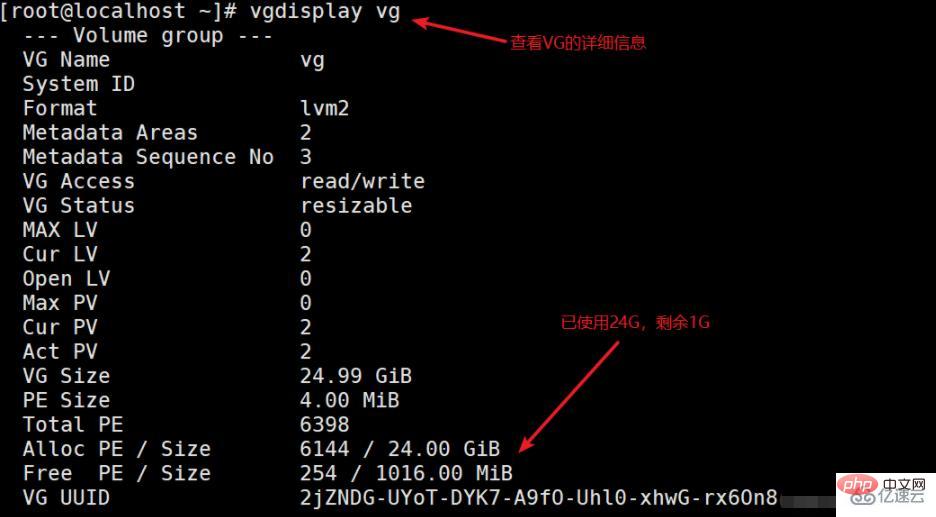
##5. Formatting and mounting
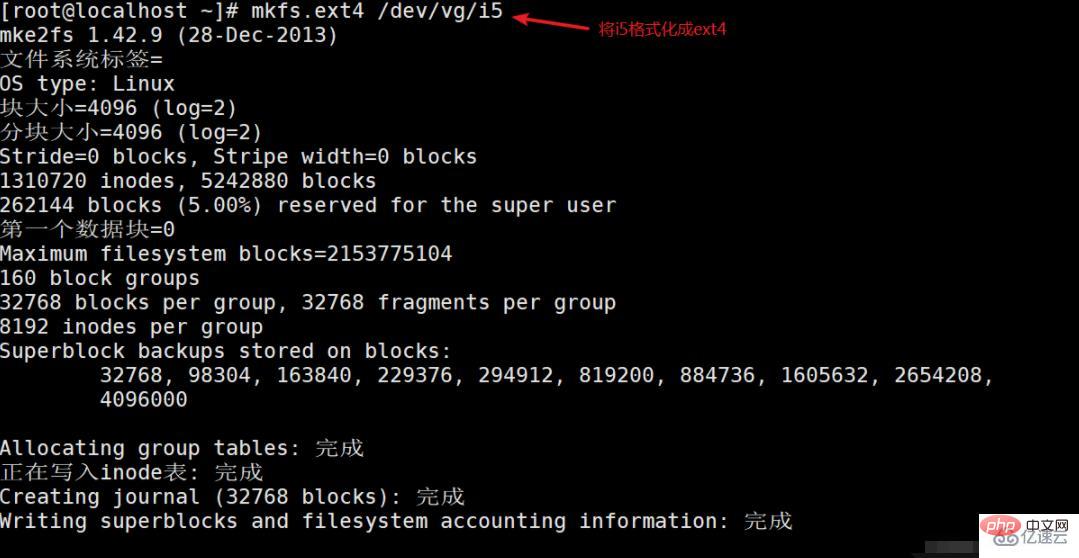
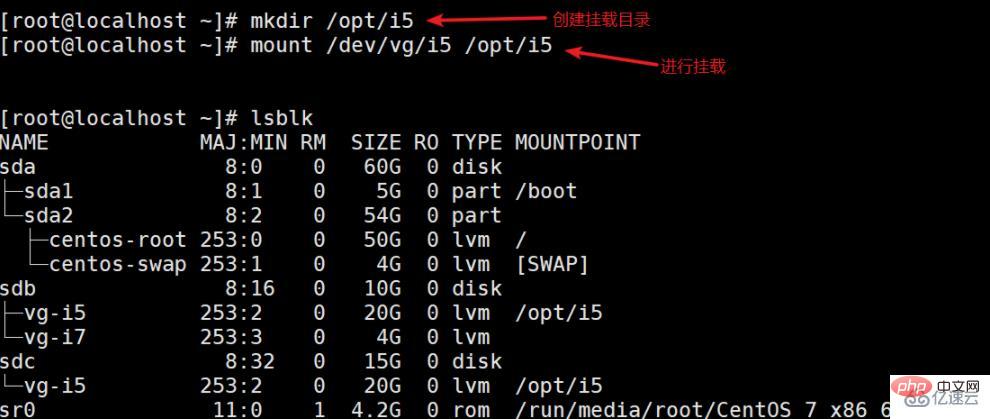
6. Logical volume expansion
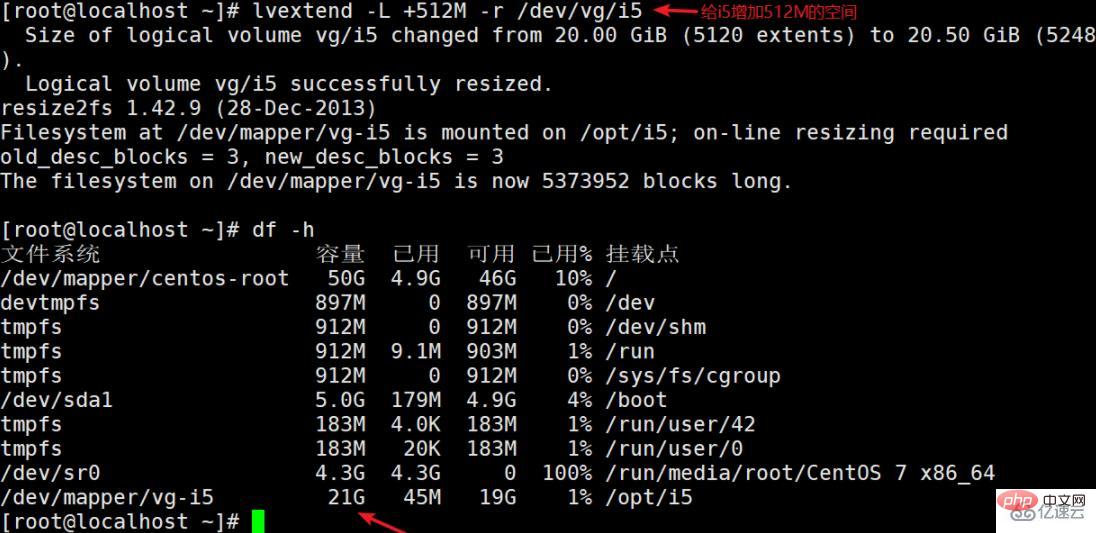
The above is the detailed content of Do you need lvm in linux?. For more information, please follow other related articles on the PHP Chinese website!

Hot AI Tools

Undress AI Tool
Undress images for free

Undresser.AI Undress
AI-powered app for creating realistic nude photos

AI Clothes Remover
Online AI tool for removing clothes from photos.

Clothoff.io
AI clothes remover

Video Face Swap
Swap faces in any video effortlessly with our completely free AI face swap tool!

Hot Article

Hot Tools

Notepad++7.3.1
Easy-to-use and free code editor

SublimeText3 Chinese version
Chinese version, very easy to use

Zend Studio 13.0.1
Powerful PHP integrated development environment

Dreamweaver CS6
Visual web development tools

SublimeText3 Mac version
God-level code editing software (SublimeText3)

Hot Topics
 How does the cost of ownership differ between Linux and Windows?
Jun 09, 2025 am 12:17 AM
How does the cost of ownership differ between Linux and Windows?
Jun 09, 2025 am 12:17 AM
Linux's cost of ownership is usually lower than Windows. 1) Linux does not require license fees, saving a lot of costs, while Windows requires purchasing a license. 2) Linux has low hardware requirements and can extend the service life of the device. 3) The Linux community provides free support to reduce maintenance costs. 4) Linux is highly secure and reduces productivity losses. 5) The Linux learning curve is steep, but Windows is easier to use. The choice should be based on specific needs and budget.
 How to install Linux alongside Windows (dual boot)?
Jun 18, 2025 am 12:19 AM
How to install Linux alongside Windows (dual boot)?
Jun 18, 2025 am 12:19 AM
The key to installing dual systems in Linux and Windows is partitioning and boot settings. 1. Preparation includes backing up data and compressing existing partitions to make space; 2. Use Ventoy or Rufus to make Linux boot USB disk, recommend Ubuntu; 3. Select "Coexist with other systems" or manually partition during installation (/at least 20GB, /home remaining space, swap optional); 4. Check the installation of third-party drivers to avoid hardware problems; 5. If you do not enter the Grub boot menu after installation, you can use boot-repair to repair the boot or adjust the BIOS startup sequence. As long as the steps are clear and the operation is done properly, the whole process is not complicated.
 How to enable the EPEL (Extra Packages for Enterprise Linux) repository?
Jun 17, 2025 am 09:15 AM
How to enable the EPEL (Extra Packages for Enterprise Linux) repository?
Jun 17, 2025 am 09:15 AM
The key to enabling EPEL repository is to select the correct installation method according to the system version. First, confirm the system type and version, and use the command cat/etc/os-release to obtain information; second, enable EPEL through dnfinstallepel-release on CentOS/RockyLinux, and the 8 and 9 version commands are the same; third, you need to manually download the corresponding version of the .repo file and install it on RHEL; fourth, you can re-import the GPG key when encountering problems. Note that the old version may not be supported, and you can also consider enabling epel-next to obtain the test package. After completing the above steps, use dnfrepolist to verify that the EPEL repository is successfully added.
 How to choose a Linux distro for a beginner?
Jun 19, 2025 am 12:09 AM
How to choose a Linux distro for a beginner?
Jun 19, 2025 am 12:09 AM
Newbie users should first clarify their usage requirements when choosing a Linux distribution. 1. Choose Ubuntu or LinuxMint for daily use; programming and development are suitable for Manjaro or Fedora; use Lubuntu and other lightweight systems for old devices; recommend CentOSStream or Debian to learn the underlying principles. 2. Stability is preferred for UbuntuLTS or Debian; you can choose Arch or Manjaro to pursue new features. 3. In terms of community support, Ubuntu and LinuxMint are rich in resources, and Arch documents are technically oriented. 4. In terms of installation difficulty, Ubuntu and LinuxMint are relatively simple, and Arch is suitable for those with basic needs. It is recommended to try it first and then decide.
 How to add a new disk to Linux
Jun 27, 2025 am 12:15 AM
How to add a new disk to Linux
Jun 27, 2025 am 12:15 AM
The steps to add a new hard disk to the Linux system are as follows: 1. Confirm that the hard disk is recognized and use lsblk or fdisk-l to check; 2. Use fdisk or parted partitions, such as fdisk/dev/sdb and create and save; 3. Format the partition to a file system, such as mkfs.ext4/dev/sdb1; 4. Use the mount command for temporary mounts, such as mount/dev/sdb1/mnt/data; 5. Modify /etc/fstab to achieve automatic mount on the computer, and test the mount first to ensure correctness. Be sure to confirm data security before operation to avoid hardware connection problems.
 Where are system logs located in Linux?
Jun 24, 2025 am 12:15 AM
Where are system logs located in Linux?
Jun 24, 2025 am 12:15 AM
Logs in Linux systems are usually stored in the /var/log directory, which contains a variety of key log files, such as syslog or messages (record system logs), auth.log (record authentication events), kern.log (record kernel messages), dpkg.log or yum.log (record package operations), boot.log (record startup information); log content can be viewed through cat, tail-f or journalctl commands; application logs are often located in subdirectories under /var/log, such as Apache's apache2 or httpd directory, MySQL log files, etc.; at the same time, it is necessary to note that log permissions usually require s
 Fixed the failure to upload files in Windows Google Chrome
Jul 08, 2025 pm 02:33 PM
Fixed the failure to upload files in Windows Google Chrome
Jul 08, 2025 pm 02:33 PM
Have problems uploading files in Google Chrome? This may be annoying, right? Whether you are attaching documents to emails, sharing images on social media, or submitting important files for work or school, a smooth file upload process is crucial. So, it can be frustrating if your file uploads continue to fail in Chrome on Windows PC. If you're not ready to give up your favorite browser, here are some tips for fixes that can't upload files on Windows Google Chrome 1. Start with Universal Repair Before we learn about any advanced troubleshooting tips, it's best to try some of the basic solutions mentioned below. Troubleshooting Internet connection issues: Internet connection
 What is the sudo command and when should I use it?
Jul 02, 2025 am 12:20 AM
What is the sudo command and when should I use it?
Jul 02, 2025 am 12:20 AM
sudo stands for "substituteuserdo" or "superuserdo", allowing users to run commands with permissions of other users (usually root). Its core uses include: 1. Perform system-level operations such as installing software or editing system files; 2. Accessing protected directories or logs; 3. Manage services such as restarting nginx; 4. Modify global settings such as /etc/hosts. When using it, the system will check the /etc/sudoers configuration and verify the user password, provide temporary permissions instead of continuously logging in as root, ensuring security. Best practices include: only when necessary, avoid blindly executing network commands, editing sudoers files with visudo, and considering continuous operations.






